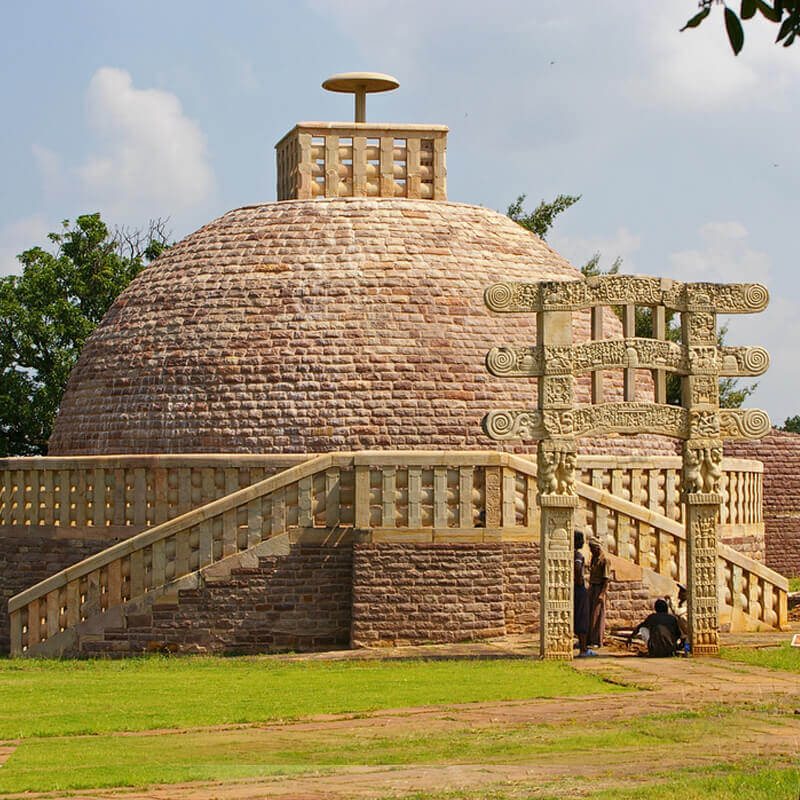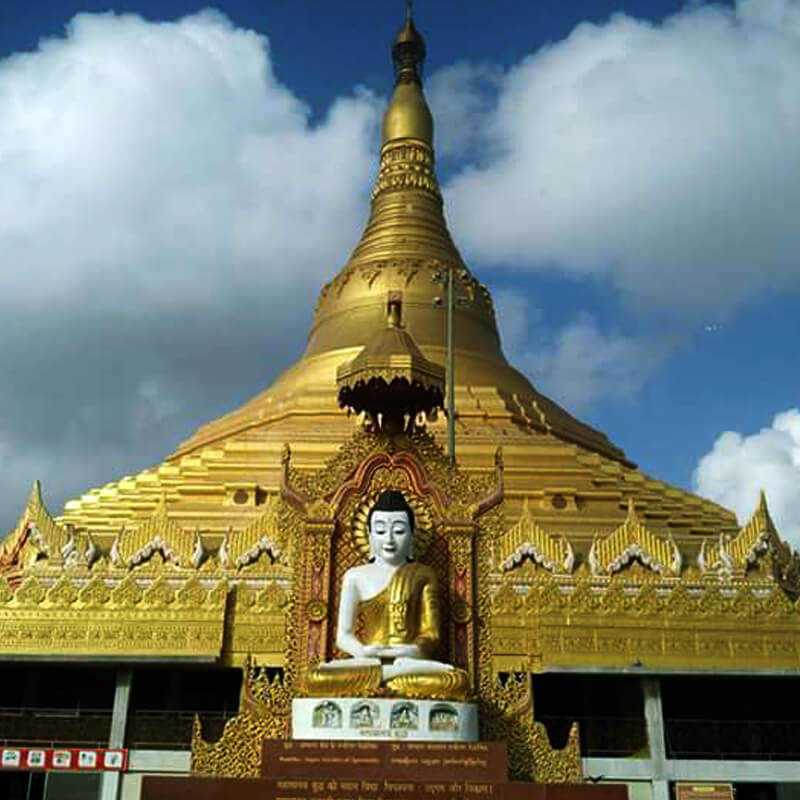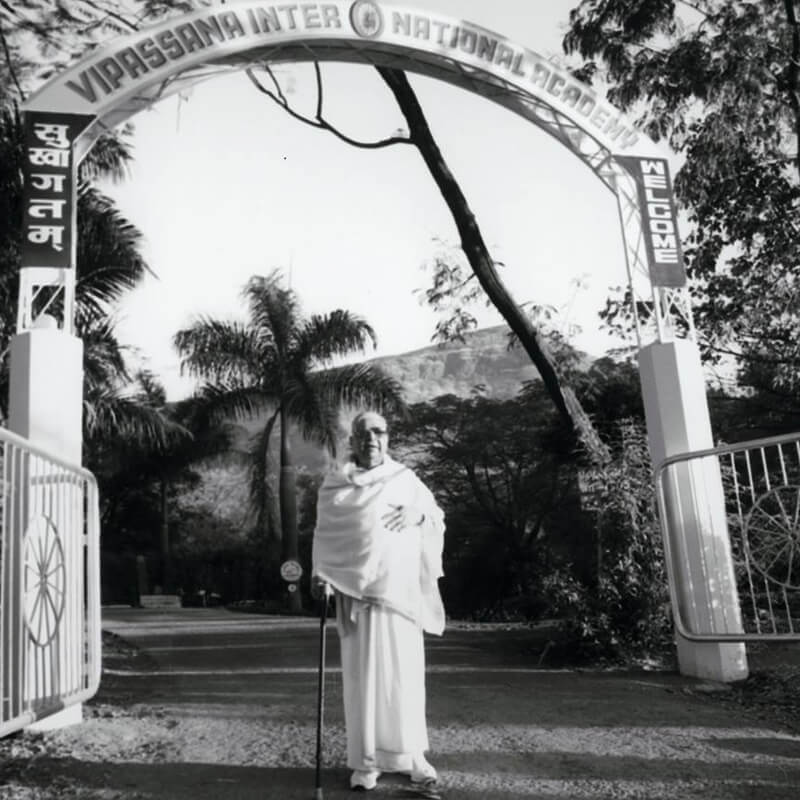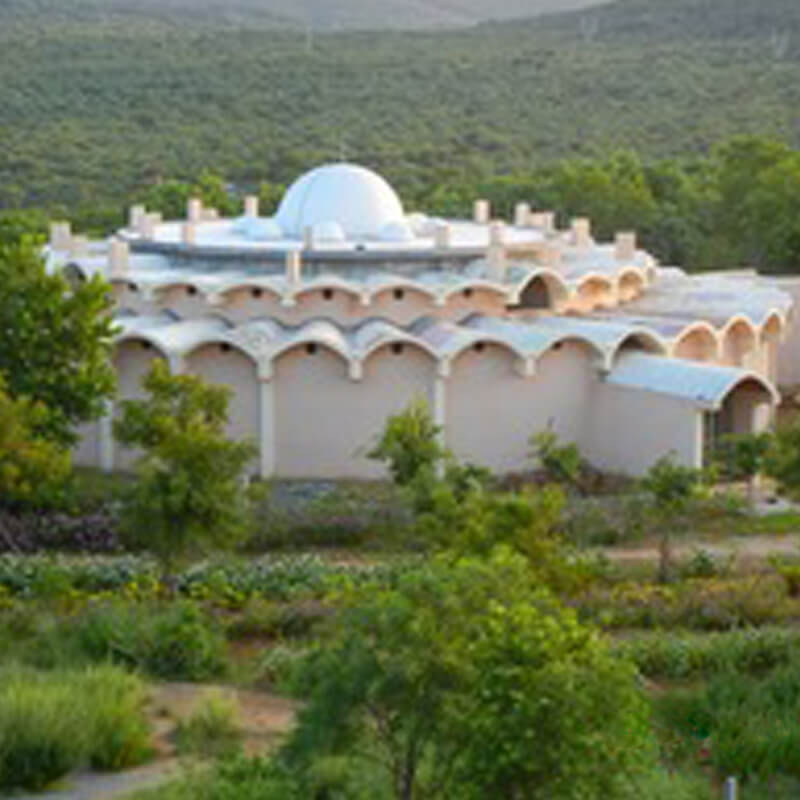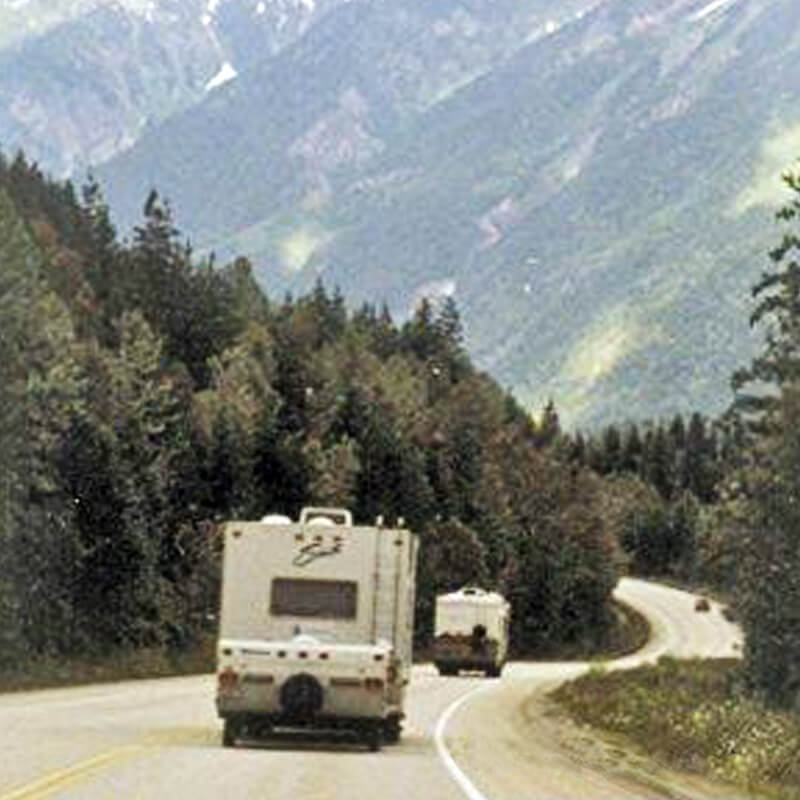The countries of East and Southeast Asia all received the teaching of the Buddha long ago, and it has become part of their culture and tradition. All that was missing was a practical technique for applying the teaching — in other words, Vipassana. Now that it is being introduced, large numbers of people are becoming attracted to it. Because they have a base of devotion to the Buddha and his teaching, they accept Vipassana willingly and work harder. We are witnessing what Sayagyi U Ba Khin described: the clock of Vipassana is striking, and now is when people around the world will learn and benefit from the Dhamma." - S.N. Goenka
From July through September of this year, Goenkaji and Mataji made an extended tour through the countries of East and Southeast Asia. Their travels started in mid-July with a one-week stay in Myanmar. While in the capital of Yangon, Goenkaji gave several public talks for audiences of up to 2,000 people. He also presented the latest version of the Tipitaka CD-ROM (named Chattha Sangayana CD-ROM , produced by Vipassana Research Institute) at a meeting of senior bhikkhus and government officials, including the Minister of Religious Affairs. The week’s schedule included a visit to Mandalay, where land has been donated for a Dhamma house within the city and for a center in the surrounding area.
From Myanmar Goenkaji and Mataji proceeded to Thailand, where a full program of public talks had been arranged in Bangkok. During this visit Goenkaji donated to leading members of the Thai Sangha and to Thai Pali scholars copies of the Chattha Sangayana CD-ROM (CSCD), which now includes the text in Thai script besides many other scripts. This latest version was launched at a press conference presided over by the Minister of Science, Technology and Environment, with the cooperation of the National Electronics and Computer Technology Center. The response was enthusiastic.
While in Thailand, Goenkaji and Mataji also visited Dhamma Kamala to inaugurate the newly built meditation pagoda and to give Vipassana to participants in the center’s first 30-day course.
On July 31, they continued their journey, flying to Taiwan, where they stayed for the month of August. Once again a full program of public talks had been scheduled for audiences such as Buddhist monks and nuns, intellectuals, business people, children and young offenders. A press conference had also been arranged, as well as newspaper and television interviews. In addition, Goenkaji and Mataji were present at a one-day course in Taipei and a three-day course for old students at the temporary center of Dhammodaya, near Taichung in west central Taiwan. This property has been donated for the next two years, during which time continuous courses will be held there. Located in a quiet rural valley, it consists of a three-storey farmhouse on one hectare (2.5 acres) of land, with a separate hall for meditation. Construction was undertaken to expand the facilities and make them suitable for a meditation center. Goenkaji and Mataji also visited Hualien, a scenic area on the east coast, where it is hoped to buy land for a permanent center.
They then proceeded to the southern city of Kaohsiung, where they were present at a 10-day course for 375 students — one of the largest courses ever held outside India. Many of the participants in this course were schoolteachers. While in Kaohsiung, Goenkaji met with the Deputy Mayor, who announced that schoolteachers from the area who attend a Vipassana course will receive credit points for their professional training. When enough schoolteachers are familiar with Vipassana, the plan is to introduce a school program for children, along the lines of the one in India.
On the program as well were visits to monasteries and meetings with senior Buddhist monks and nuns. As always in Taiwan, the interest in the teaching was extraordinary, and large numbers of people showed eagerness to learn Vipassana.
On August 30, Goenkaji and Mataji flew on to Hong Kong for a brief stay, during which three public talks had been arranged. In the audience each evening were about 500 people, including many intellectuals. Earlier, in the month of July, a 10-day course had been conducted by assistant teachers near Hong Kong, and another course has been planned for December. While Goenkaji and Mataji were there, a building was offered as a site for holding courses on a continuing basis. It can accommodate 60 to 80 people.
After Hong Kong the next stop was Cambodia, the first time that Goenkaji and Mataji had been to this country. Despite security dangers they went ahead with their plans in order to encourage local meditators who have been working tirelessly to re-establish the Dhamma in their homeland. The program included several public talks; in the audience were government officials, Buddhist monks and scholars, and lay people. A highlight was the presentation of the CSCD in Khmer script.
Later stops on the trip were Singapore and Malaysia. The program again included group sittings with Vipassana meditators, an interview with a Kuala Lumpur newspaper, public talks for audiences of as many as 400 people, and presentation of the CSCD to Pali scholars. Four 10-day courses have now been held in Malaysia, and the demand continues to grow in the region.
Goenkaji and Mataji returned to India in early October, knowing that the seeds sown in the countries they visited have sprouted and become flourishing plants.
Detailed Country wise report
Myanmar Report : 14th July to 23rd July '98
Goenkaji and Mataji arrived in Yangon on the 14th of July '98. During their stay, Goenkaji gave several well-attended public talks in Yangoon. One of the talks was held in a large hall, with a two thousand-strong eagerly listening audience. He also visited Shwe Dagon Pagoda, where he had a detailed discussion with architects about the design aspects of the new Vipassana Pagoda being built atMumbai, India. During the visit to Dhamma Joti, the Vipassana centre in Yangon, he participated in a group sitting, and then gave an inspiring talk about the duties and responsibilities of the Trustees and Dhamma workers – to help them maintain the purity of the Vipassana Tradition.
He also visited Mandalay, the second largest city in Myanmar. There he gave two discourses in halls overflowing with people, and answered many questions regarding the practice of Vipassana. A site was donated for the construction of a Dhamma House in the centre of the city. He was also shown two sites for the construction of a Vipassana centre, out of which he selected a site about 15 Km from the city. This will be the third Vipassana centre in Myanmar. The Dhamma is spreading rapidly in the "Suvanna Bhumi"(the Golden land), which so carefully preserved the true teachings of the Enlightened One.
Thailand Report : 24th July to 30th July
Goenkaji and Mataji reached Thailand on 24th July '98. They visited Dhamma Kamala to inaugurate the new Pagoda building there, and gave Vipassana to students in the ongoing 30-day course. They also led a group sitting of over 300 old students to mark the opening of the Pagoda.
Back in Bangkok, Goenkaji addressed six public talks, with an audience comprising of Thais and other nationalities ranging from business executives to scholars, lecturers, university students, medical faculty members, and Buddhist monks.
The Chattha Sangana CD-ROM (CSCD) version 2.0, now containing the Thai script besides other six scripts, was launched in a press conference presided by the Minister of Science, Technology and Environment, with the co-operation of the National Electronics and Computer Technology Center. Demonstrations of the CSCD were arranged at various sites, amongst enthusiastic Pali scholars and those interested in studying Buddha's words. The CSCD was received very enthusiastically by all the scholars. Demand is pouring in for copies of the CSCD, which is available free of cost to all those who can use it.
While in Bangkok, Goenkaji had an audience with Thailand 's Supreme Partriach (Head of the Thai Sangha) and presented him with the CSCD and the printed sets of Tipitaka 21 volumes (56-76). A keen Buddhist scholar, the Supreme Patriarch was very pleased with VRI's effort in making the Pali text easily available to people throughout the world. He and his followers were so impressed with the versatility and usefulness of the CSCD that he later asked for more copies.
Meditation Pagoda for Dhamma Kamala in Thailand
During their recent visit to Thailand in July, Goenkaji and Mataji inaugurated the new meditation pagoda at Dhamma Kamala — the first of its kind at a Vipassana center in Thailand. The pagoda contains 48 completed cells, with the number eventually to rise to 120. The structure also includes a meditation hall. The roof is in the shape of a traditional Thai pagoda, towering approximately 25 meters (83 feet) above the grounds of the center. Construction was completed just in time for the start of the first 30-day course at Dhamma Kamala. Twenty-eight meditators participated, including 10 foreigners and 18 Thai students.
Goenkaji and Mataji came to the center to give Vipassana on Day 11 of the course. Later that day, they led a group sitting for 300 old students to mark the opening of the pagoda. Interest in Vipassana is spreading rapidly throughout Thai society. As a result, more centers are being established and the demand is growing for courses in outlying areas. The second center at Phitsanulok, northern Thailand, is currently under development. The first course is expected to be held there in 1999. Non-center courses are being held at Khon Kaen in north-eastern Thailand and other locations. In addition, a large tract of land has been donated for a third center at Chumporn, in southern Thailand.
Patipatti and Pariyatti are both being eagerly absorbed by the people of this great nation, where a large percentage have unshakable faith in the Buddha’s teachings.
Taiwan Report :July 31st to 30th Aug
Goenkaji arrived in Taiwan on July 31. He maintained a busy and productive schedule there throughout the month of August, tirelessly and enthusiastically explaining and spreading Dhamma. On his first full day in Taiwan, Goenkaji attended a press conference which had both newspaper and television coverage.
Favorable articles highlighting his teaching of Vipassana and the schedule for the month appeared in major newspapers after the conference. They included brief descriptions of Vipassana and its rapid spread in Taiwan. Goenkaji also gave several individual interviews to major newspapers and to a number of television stations.
Goenkaji's trip began in the north of Taiwan with public talks, meetings and a one-day course in Taipei. He spent about a week in west central Taiwan at the temporary center, Dhammodaya, in Taichung. There, he was present for an Anapana course for health professionals and a three-day old student course. InTaichung, he also visited a number of properties with the Trustees, looking for a permanent site for the center. Goenkaji then spent the next two weeks in the city of Kaohsiung, southern Taiwan, where he was personally welcomed by the mayor of that city. In Kaohsiung, a ten-day course for 375 students was held, along with a simultaneous Anapana course for 75 business professionals.
Goenkaji concluded his month stay in Taiwan with a public talk in Taipei, which was attended by about 370 people.
Goenkaji was invited to meet with some of the most renowned monks and nuns of Taiwan. Early in his trip, he was warmly received by the Venerable Sheng-Yen at the Dharma Drum monastery in northern Taiwan. There, Goenkaji was invited to give a Dhamma talk explaining the unique aspects of Vipassana meditation to the monks and nuns who live at the monastery.
Goenkaji had useful discussions with Venerable Kuang Hsin who is building a large monastery near Taichung. He invited Goenkaji to conduct Vipassana courses in the facilities at the monastery after it was completed. In Taichung, Goenkaji conducted a three-day course for old students, a three-day Anapana course for the health professionals and gave public discourses.
He also traveled to Hualien in Eastern Taiwan on the invitation of Venerable Cheng Yen to visit her at her monastery. Venerable Cheng Yen is also known as "The Mother Teresa of China" , for her tireless charity work throughout the country.
Later, in Kaohsiung, the first of two evening series public talks given by Goenkaji was introduced with great warmth by the head of the Sangha of Taiwan, Venerable Ching Hsin. The second of these talks was introduced by the head of the Sangha of Kaohsiung. In addition to these, Goenkaji also met with several other respected monks and nuns ofTaiwan.
Goenkaji gave numerous Dhamma talks to a wide variety of audiences, explaining the importance of working with vedana (body sensations), presenting it within various topics such as "Be Your Own Master," "The Development of Wisdom", "The Heart of Compassion" as well as in his well-known "Art of Living" talk.
In addition to his busy public schedule, Goenkaji gave Anapana, Vipassana and Metta instructions on the different courses that were held during his visit. He also gave noon interviews throughout these courses. He met several times with various groups of old students to support and advise them regarding the growth of Dhamma in Taiwan.
The historic big course in Taiwan, the largest ever held outside of India, was held at an elementary school during the summer vacation in the middle of the city of Kaoshiung. About 370 students attended, of which around two-thirds were female. About 100 were old students.
The course was conducted by Goenkaji and Mataji, who were present for Anapana, Vipassana and Metta sessions and also for noon-time interviews on most days of the course. They were assisted by two teachers and five assistant teachers. There were around 40 Dhamma workers including about six able interpreters. The Chinese vegetarian food was excellent, and arranged and cooked mostly by old students.
The facilities at the school, although not ideal, were very spacious as it normally has around 5,000 students. The large hall on the top floor was air-conditioned. (This helped to block out the down-town traffic noise.) As an experiment only, a concurrent three-day Anapana course for about 70 business executives was conducted in a separate hall, from Day 8 of the course onwards.
Goenkaji gave many public talks in Taiwan. One particularly inspiring talk at the end of the large course was about the benefits of giving Dhamma Service. Future courses in Taiwan are being held twice a month at a new site inTaichung, which has been given on loan for two years. It is in a pretty rural valley and has room for about 70 students.
Dhamma is taking roots steadily in this "Island of Dhamma".
Hong Kong Report : 30th Aug to 3rd Sept '98
Goenkaji’s group arrived at Hong Kong’s new airport on 30th August and was received by a group of old students there. A few hours later, Goenkaji and Mataji met with old students in the same evening at a Club House near his residence. He meditated with old students and answered some of their questions.
On 31st August, Goenkaji and Mataji visited the head of Hong Kong Buddhist Association, Rev Master Kwok Kong, accompanied by Rev Master Yuen Quing. The two spiritual leaders freely exchanged their views about Budha's teaching and the spreading of Dhamma. In the same evening, Goenkaji and Mataji visited the Hindu Temple to meet with the Indian community and gave an outline about Vipassana to about 60 people who attended this meeting. Goenkaji also gave two public talks during the evenings of 1st and 2nd September at the Chi Lin Nunery to an audience of about 450 people. On the 1st evening Goenkaji gave a brief outline on what Vipassana is, and during the second evening he gave an introduction about the technique. On both occasions, he answered some interesting questions from the enthusiastic audience.
Prior to his departure for Cambodia on 3rd September, Goenkaji and his group found time to visit the big Buddha at the famous Po Lin Monastery on the Lantau Island, as well as to have dinner with a local politician & industrialist Mr.Yeung Chiu, brother of an old student in New York.
Dhamma is starting to get established in this leading business centre of Asia.
Cambodia Report : 3rd Sept to 6th Sept '98
This was the first visit of Goenkaji to Cambodia on a Dhamma-Duta mission. Since 1992 Vipassana courses have been held in this country and attended by an increasing number of locals. In 1995 a center was established nearPhnom Penh. Apart from Vipassana courses for adults, a number of Anapana Meditation course have been held for children. Most courses are overbooked and invariably, demand exceeds capacity.
In 1998, just a few months prior to Goenkaji’s visit, a permanent office / Dhamma House (with facilities for group sittings) was established in a separate building within the grounds of the Wat Ounnalom temple in Phnom Penh. It greatly facilitated the coordination and the cohesiveness of Dhamma work in the city. Group sittings are held there several times daily. Meetings of old students are held every Sunday.
Goenkaji and Mataji arrived late evening on 3rd September in Phnom Penh. The following morning, a Dhamma Talk was given at the Buddhist Institute and the Chattha Sangayana CD-ROM was presented. This CSCD now also contains the Khmer script. As both the Buddhist Institute itself, and the Buddhist University (the sole university for monks in the country) lacked computers able to run the CSCD; necessary upgrades were made (with donation by Vipassana students) prior to Goenkaji’s trip. In addition, immediately after Goenkaji’s trip, a Computer with CD drive was bought for the Dhamma House/Vipassana office in Phnom Penh, to enable monks and lay people without computer access to view the CSCD. This will be a boon to the Pali scholars, as the printed volumes of Tipitaka in Khmer script are very scarce, and many of the Atthakathas, Tikas and other volumes contained in the CSCD are not at all available.
On the afternoon of 4 September, Goenkaji gave his first public Dhamma talk in Cambodia, at the Phnom Penh Institute of Technology. This drew an audience of approximately 175. The talk was very well received and generated a lot of questions from the audience. The same evening Goenkaji conducted a group sitting for old students at the Dhamma House at Phnom Penh, attended by about 100 local meditators.
On the morning of 5th September, Goenkaji gave a Dhamma talk specifically for the Buddhist clergy (monks and nuns) at the Buddhist University. Due to the enormous interest, it was necessary to hold the talk under a tent erected on the University grounds, as the meeting room was too small. About 300 members of the Sangha attended. The talk was very well received and generated voluminous questions, only a fraction of which could be addressed within the 2 1/2 hours time available.
On the afternoon of 5 September, Goenkaji gave his second talk to the general public at a public hall called Salle Chaktumok. This was attended by approximately 700 people -- an astonishing number for Cambodia (the population of Phnom Penh is less than one million). About 500 lay people and nuns sat in the audience and over 200 monks sat behind Goenkaji on the podium. It was observed that many of the same people who had attended the previous day's public talk returned, this time bringing friends and family with them. Again, the audience responded with many more questions than the allotted time could handle, with the content of questions indicating serious interest. Over 500 course applications were taken between this and the previous day's public talk by the participants.
Another important event took place on 5 September -- the new Teacher appointment of a Cambodian Bhikku, Ven. Ouk Sophearind by Goenkaji. This brings the total of Cambodian Vipassana Teachers to 5. Most important, it is the first appointment of a Cambodian who lives in Cambodia, and will greatly facilitate the scheduling of more courses. Limited availability of teachers to conduct courses has been the greatest limiting factor to expanding the number of courses to meet demand.
On 6 September Goenkaji travelled to the Cambodia Vipassana Center, fulfilling a strong desire by him and of Vipassana meditators in Cambodia. As travel to the Center involves 2 hours on extremely bad road followed by a rough barge trip across the river, it was initially thought to be impossible for Goenkaji to make the trip due to his delicate health. Finally, through the diligent efforts of all, a solution was identified - a large cruise boat was rented to take him and Mataji across the river. They spent about three hours at the Center, and conducted a group sitting for about 120 old students.
While at the Center, another important event occurred: in Goenkaji’s presence, the first official Cambodia Vipassana Trust was established. Nine serious Dhamma workers were instructed in the roles and responsibilities of a Trust. This was a great step forward as the Dhamma work had until then been conducted on an ad hoc basis.
May the practice of Dhamma bring lasting peace to this strife-torn Dhamma land.
Singapore and Malaysia Report : 8th September to 3rd October:
Goenkaji arrived in Kuala Lumpur on 2oth September. On the next three evenings, he had public talks in a Chinese temple, the Dhammananda's Brickfields Temple where there was also a demonstration of the CSCD version 2.0. There was also a talk to the Indian community at a government auditorium.
On the conclusion of the four day tour of Malaysia, Goenkaji returned to Singapore and the CSCD was launched at the Pali Institute on the same night. A lot of interest was generated in the new version of CSCD.
There were several public talks for the following days. Attempts are on to find a course site in Singapore and hopefully, the first Vipassana course will be held in this high-tech city.

